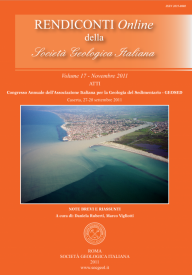
Biogeochemical characterization of automicrites building the Cipit Boulders of the Ladinian – Carnian platforms in the Dolomites (northeastern Italy)
Tosti F. (*), Guido A. (*), Demasi F. (*), Mastandrea A. (*) & Russo F. (*)
(*) Dipartimento di Scienze della Terra, Università della Calabria, Via Bucci Cubo 15b, 87036 Rende (CS), Italy. E-mail: fabio.tosti@unical.it
DOI: https://doi.org/10.3301/ROL.2011.52
Volume: 17/2011
Pages: 179-183
Abstract
The sedimentological features and the microfacies of the Cassian platforms (Late Ladinian – Early Carnian) of the Dolomites (northeastern Italy) can be studied only on the basis of the so called "Cipit boulders", that are platform-derived olistoliths and clasts fed to the basin and escaped to the extensive dolomitization affecting the platform limestone.
The Punta Grohmann section (Sassolungo, Western Dolomites) is one of the most classical Late Ladinian – Early Carnian basin successions (Wengen and S. Cassiano Formations) of Dolomites in which several levels containing gravity-displaced carbonate olistoliths occur. The carbonate platforms, from which the olistoliths derive, were made up mainly of carbonate mud, interpreted as microbialite, and therefore they can be regarded as "mud mounds" (Russo et alii, 1997, 1998).
Skeletal organisms (Tubiphytes, skeletal cyanobacteria, sphinctozoan sponges, etc.) represent a minor component of the rock (usually less than 10%). On the contrary the composition of Cipit boulders is dominated by the micritic fraction (about 60%), mainly represented by automicrite, with subordinate amounts of micrite interpreted as detrital (allomicrite).
The microbialites or automicrites, which may exhibit both dense microcrystalline (aphanitic) or peloidal microfabric, are sometimes organized in stromatolitic laminae or thrombolitic fabric. The organic-induced nature of microbialite was supposed on the base micromorphological evidence and epifl uorescence observations (Russo et alii, 1997).
To corroborate the microbialitic model of Russo et alii (1997) for the Late Ladinian – Early Carnian platforms buildups, biogeochemical analyses have been carried out on selected samples of carbonate boulders. Fourier Transformed Infra-Red (FT-IR) spectroscopy and Gas Chromatography Mass Spectrometry (GC-MS) analyses have been performed to confirm the presence of organic matter remains and identify the metabolic signature of bacteria/cyanobacteria.
The geochemical characterization of extracted organic matter shows a great prevalence of the aromatic fraction over the aliphatic and carboxylic ones.
The FT-IR spectra reveal the presence of stretching C=C vibrations attributable to alkene and/or unsaturated carboxylic acids, that may be synthesized by microbes. GC-MS investigations indicate the presence of extended hopane series, short chain methyl-steranes (C22, C23), straight chain saturated (C14, C16), monounsaturated (C17:1, C18:1), and diunsaturated C18-acids, diagnostic of microbial activity.
All data confi rmed the presence of bacteria/cyanobacteria communities during platform deposition, indicating that microbes have played a prominent role in the genesis of these carbonates. These communities created the chemical conditions that triggered the induced precipitation of great volumes of syndepositionally-cemented automicrites, which stabilized the carbonate bodies controlling their depositional geometries.
Keywords
Get Full Text